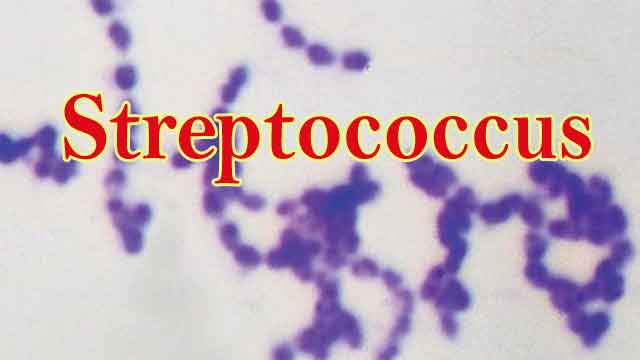Streptococcus- They are gram positive cocci, motile, non-sporing and arranged in chains. They are pathogenic to humans and cause pyogenic infections with a characteristic tendency to spread. They need media enriched with blood serum ascitic fluid for their growth.
Streptococci can be grouped on the basis of their morphology, cultural character, biochemical reactions, antigenic structure.
Morphologically, they could be grouped into long chain streptococci which are pathogenic and short chain nonpathogenic streptococci. However, this mode of classification is not suitable because the length of chain depends upon certain experimental conditions like nature of medium.
Streptococci are grouped into two classes on the basis of structural character such as obligative anaerobes peptospirococci and aerobes or facultative anaerobes. There are aerobic streptococci which are further classified into two subclasses on the basis of hemolytic property on blood agar plate, alpha hemolytic and beta hemolytic.
Streptococci are classified on the basis of biochemical reactions such as fermentation .fermentation process is employed to differentiate different species of streptococci, mannitol is fermented by streptococci while streptococci pyogenes and streptococcus veridians do not ferment mannitol at all.Sreptocci could be classified on the basis of antigenic structure.
The aerobic streptococci producing beta hemolysins are divisible into Lancefield group A,B,C,D,E,F,G,H,K,L,M,N,O,P,Q,R,S,T,U,V, on the basis of specificity of polysaccharide-C hap ten present on the cell wall. A majority of hemolytic streptococci that cause infections to humans belong to group A. hemolytic streptococci of group A is called Streptococcus pyogenes. It can be further subdivided into types based on protein M, T, R present on cell surfaces known as Griffith typing. Several GRIFFITH types of S. pyogenes have been identified till date.
Streptococcus pyogenes is aerobic and facultative anaerobe with optimum temperature of growth being 37 centigrade. Streptococcus pyogenes is more invasive and produces septicemia readily can spread locally along lymphatics and through blood stream.
Respiratory tract infections are caused by this microorganism. It may be localized in tonsilitis or may involve pharynx. From throat, streptococci may spread to surrounding tissue causing otitis media, mastoiditis, Ludwig angina and suppurative adenitis.it may cause meningitis. Sometimes streptococcus pyogenes may lead to bronchopneumonia when this organism acts as second invader influenza. Scarlet fever consists of combination of sore throat and a generalized erythromatous rash. It is produced by strain producing the erythrogenic toxin.
Skin infections such as suppurative infections of skin, e.g., wounds, lymphangitis, cellulitis can also arise. There are two typical skin infections caused by this organism erysipelas and impetigo. These very skin infections are the main causes of acute glomerulonephritis in children especially in the tropics.
Streptococcus pyogenes may also cause infection of nasopharynx.it cam also attack genital tract.
Streptococcus toxic syndrome is a clinical condition which results in the collapse of entire organs system leading to death. There are other infections caused by streptococcal pyogenes such as skin lesions, eczema, scabies, wounds and burns. Not only this, septicemia, abscess in internal organs such as brain, lungs, liver and kidneys are not spared.
Some streptococci do not produce soluble hemolysin. It is characterized by production of alpha hemolytic colonies on a culture medium such as blood agar. It includes streptococcus viridians, S. mitis, S. salivarium. Streptococcus viridians is present as a commensal on the mucosa of mouth, nasopharynx and saliva of man. Streptococcus salivarium is nonpathogenic found in mouth and intestine of man.
Streptococcus mitis does not grow at high temperature.
Anaerobic streptococcus such as Pepto streptococcus putrid has natural habitat in female genital tract.
Streptococcus can be diagnosed in the laboratory by hematological investigations such as total leucocyte count which may show a considerable increase Differential leucocyte count show increase in neutrophil count. Polymorph neutrophil count may constitute more than 80 percent. Erythrocyte sedimentation rate may rise in rheumatic disease.
Skin test can also be performed which is called Dicks test. It is done to find out persons susceptibility of a person to scarlet fever.
Other laboratory investigations would be bacteriological methods in which specimens from throat, swab, nasopharynx, sputum, cerebrospinal fluid, blood is taken and investigated. Specimen is collected according to the site of lesion, such as swab, pus, swab or blood. Specimens may be collected in sterile containers under all possible aseptic conditions. These should be placed in Pikes transport medium, blood agar containing 1,000000 crystal violet and 1 in 160000 sodium azide.
The treatment would consist of Penicillin G. It is supposed to be the drug of choice. However, in patients allergic to penicillin G or its derivatives, can be treated with Erythromycin, cephalosporins.








0 Comments